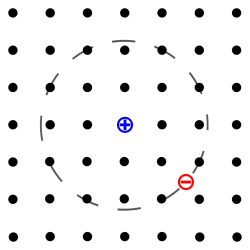If you read the scientific literature, you see the familiar subatomic particles you learned about in school: protons, neutrons, and electrons. If you are young enough, you see others you probably heard about, too, like quarks and gluons. But recently there has been a lot of buzz about excitons and even some transistor circuits demonstrated that use them. But what is an exciton?
It actually sounds like a subatomic particle, but it is a little more complicated than that. An exciton is a bound state of an electron and an electron hole and is technically a boson. You are probably familiar with the idea of an electron hole from semiconductor physics. Technically, it is a quasiparticle. The reason scientists are interested in the beast is that it can transport energy without transporting net electric charge. That is, the state itself is neutral, but also contains energy.
Exciting Times for an Exotic Particle
This one-minute cartoon from École Polytechnique Fédérale de Lausanne (EPFL) is a good way to wrap your head around why excitons are exciting.
EPFL had the breakthrough last year that allowed room temperature exciton transistors. The paper that explains it all isn’t quite as entertaining, but you can find it as “Room-temperature electrical control of exciton flux in a van der Waals heterostructure” in the usual places (https://doi.org/10.1038/s41586-018-0357-y).
 One way to form an exciton is to hit a material with a photon above its bandgap energy. This moves an electron from the valance band into the conduction band. The new spot on the conduction band is the electron and the hole back on the valence band is bound to the electron by electrostatic force. In particular, the hole’s attraction to all the surrounding electrons keeps everything stable. It also consumes a bit of the pair’s energy.
One way to form an exciton is to hit a material with a photon above its bandgap energy. This moves an electron from the valance band into the conduction band. The new spot on the conduction band is the electron and the hole back on the valence band is bound to the electron by electrostatic force. In particular, the hole’s attraction to all the surrounding electrons keeps everything stable. It also consumes a bit of the pair’s energy.
 Oddly, excitons aren’t new. They were first proposed in 1931 by a guy named Yakov Frenkel (pictured). He actually was describing something observed by H. H. Poole involving conduction in insulators. In fact, Frenkel introduced the idea of a hole into the physics vernacular and certain types of holes are still known as Frenkel defects.
Oddly, excitons aren’t new. They were first proposed in 1931 by a guy named Yakov Frenkel (pictured). He actually was describing something observed by H. H. Poole involving conduction in insulators. In fact, Frenkel introduced the idea of a hole into the physics vernacular and certain types of holes are still known as Frenkel defects.
Work continues to make excitons practical. Cornell recently announced they increased the condensation temperature for excitons significantly (from 1 kelvin to 100 kelvin; still a long way from room temperature).
Waiting is the Hardest Part
What will this mean for us? Nothing this week. But someday in the future, the IC you are using might just take advantage of these exotic particles. While that might sound far-fetched, imagine how crazy it would have sounded to a tube radio designer in the 1930s that in just a few decades we’d have something that acted like a tube, would fit on your fingernail, and be totally rugged by comparison to a tube.















bosun -> boson?
autocarrot strikes again!
bosom buddies
I was gonna say…!
Also, someone fetch me one of those cartoon red headache bottles. I’m not smart enough to be here!
Fixed, thanks!
It ain’t real til you can buy it from Digikey.
What a sparse article.
“You have a strong background in semiconductor physics, right”
“Exciton is a thing”
“Watch this video (summary: it’s a thing that now exists at room temp.)”
“There’s a way to make an exciton”
“People are still doing research”
“The present would sound weird to people in the past, right? Excitons sound weird. Therefore… logical fallacy”
From the EPFL article is this handle quote:
“This breakthrough sets the stage for optoelectronic devices that consume less energy and are both smaller and faster than current devices. In addition, it will be possible to integrate optical transmission and electronic data-processing systems into the same device, which will reduce the number of operations needed and make the systems more efficient.”
That, to me, is a little more exciting than just “it’s a thing!”
s/handle/helpful/g
Exciton: particle used to carry glad tidings.
I’m waiting for the Erecton.
That’s a hard one.
Finally have some new fuel for the “free energy” machines huh? lol
Ed Asner is not excited.
You want to hit the semiconductor with a photon that is approximately one exciton binding energy _below_ the band gap, otherwise you produce an electron-home pair that is not bound to each other.
However that exciton will not last long, as the photon->exciton conversion is coherent, so the exciton will convert back to a photon and then begin the while cycle anew. But that is another story (look up “polariton” if you are interested).
Hey Al, thanks for the nice introduction!
There’s a somewhat extensive review available on exciton photonics from UPenn, see https://photonics101.com/publications/167-exciton-photonics-from-fundamental-science-to-applications
The applications shown there might be some further insight!
Take care